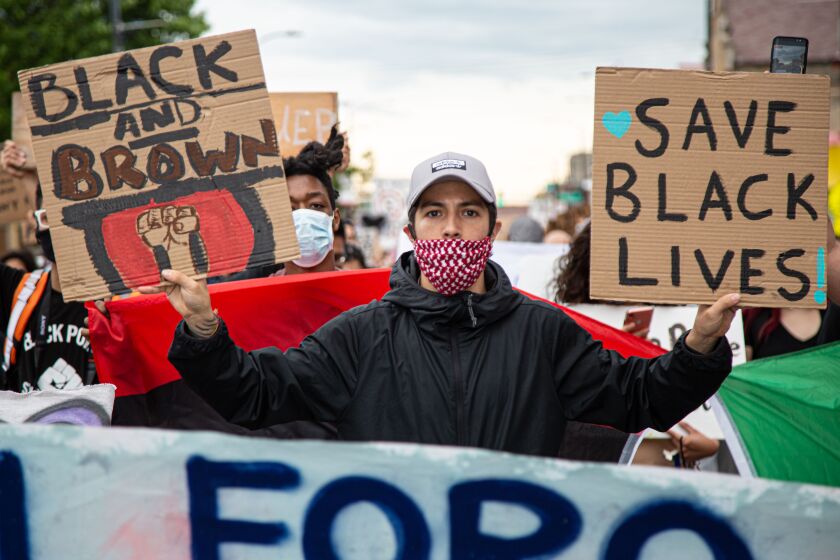The crowd was silent as residents knelt on one knee, raised their fists in the air while observing a moment of silence for George Floyd under the iconic archway welcoming the public to Little Village.
Laura Ramirez, an organizer from El Foro Del Pueblo, walked through the crowd waving burning sage, which is an indigenous tradition believed to help prayers elevate to God.
“This fight is long, and this is not going to end today,” Ramirez said to the group, many holding signs in support of the Black Lives Matter movement.
For two hours Wednesday morning, the group took over the business corridor of 26th Street in Little Village, chanting Floyd’s name and equating police to federal immigration agents. The effort comes after days of rising racial tensions among Latinos and African Americans after protests denouncing the death of Floyd led to people breaking into businesses and vandalism throughout the city.
Residents, including some gang members, tried to guard the local businesses, but the effort drew backlash as reports of racial profiling incidents spread through social media. In Back of the Yards, a shooting Tuesday morning is believed to be tied to someone asking an African American man what he was doing in the neighborhood, according to Ald. Ray Lopez, whose 15th Ward includes the neighborhood.
In Little Village, Fanny Diego Alvarez, another organizer from El Foro Del Pueblo, blamed Mayor Lori Lightfoot for protecting the Loop, pushing the demonstrations into the neighborhoods. Then when tensions mounted in the neighborhood, Diego Alvarez said Chicago police stood by and didn’t stop it.
Diego Alvarez told the crowd that accountability was the only answer, urging the city to commit to allowing a citywide elected Civilian Police Accountability Council to have oversight over the department.
Mayor Lori Lightfoot told reporters Wednesday that she spent time in North Lawndale and Little Village and learned that some incidents characterized as black and brown conflicts are actually internal gang fights.
“These are young men who really have not reached maturity and adding into that mix of youth and testosterone and weapons and maybe other things is a recipe for disaster,” Lightfoot said.
Chicago Police Supt. David Brown said these types of conflicts aren’t new, and he said conflating gang activity with protecting neighborhoods seemed “ridiculous.”
“Gang and gun conflicts have destroyed these neighborhoods; they aren’t going to protect these neighborhoods,” Brown told reporters.
Lightfoot also cautioned that some of the rumors spreading on social media about conflicts between brown and black communities might actually be part of a concerted effort to create hate and anxiety. She said the FBI was investigating similar rumors spreading in other parts of the country.
In Little Village, the crowd marching through 26th Street mostly consisted of Latinos and some African Americans. It started with indigenous rituals and dances, and a woman reminding the crowd that Floyd was killed over $20 and asked how much a life was worth.
Jai Simpson, 20, of GoodKids MadCity, an anti-violence group, said the march was the first time he visited Little Village, but he characterized the group as “family.” Speaking to the crowd, he urged gang members from Little Village and Lawndale to come to a peace agreement.
“Both black and brown communities on the South and West sides of Chicago are affected by environmental racism, racial discrimination, systematic discrimination and centuries of exclusion,” Simpson said to the crowd.
Participants in the march echoed Simpson’s sentiments. Stephanie Cerda-Ocampo, 20, said she hears the anti-black comments within her family and from her neighbors. It’s why she decided to travel to Little Village from the Southwest Side to join the group.
“We need to stick together and fight against the real issue, like white supremacy,” she said.

A protester holds two signs that read “Black and Brown” and “Save Black Lives!” during a protest on 26th Street in Little Village, Chicago, Wednesday June 3, 2020. After days of racial violence in Little Village, community residents march to defend black lives and call out the mayor for protecting downtown while turning her back on communities.
Anthony Vazquez/Sun-Times file
The crowd marched peacefully for about a mile west toward Pulaski Road and then walked back to the archway, located near the intersection of 26th Street and Albany Avenue. Along the way, the few pedestrians out used their phones to record the group. Participants handed out masks and snacks to the group and community. Two CTA buses filled with police officers trailed the group.
Veronica Gonzalez, 30, stepped out of a laundromat on 26th Street to take photos of the group. She said she was scared if businesses were destroyed in the neighborhood, the owners would be excluded from any relief because of their immigration status. Many properties along 26th Street remained boarded up.
“Seeing them together, it brings a lot of joy,” Gonzalez said as the crowd walked by. “Nobody is against them.”
Ald. Michael Rodriguez, whose 22nd Ward includes Little Village, said he had spent hours each day this week on the streets and had seen some racial conflicts that he described as “horrific.” By Wednesday, he said community outreach workers had come to an agreement with people involved in the conflicts, he said.
”I’m hopeful that things have become more peaceful, and I hope it stays that way,” Rodriguez said.
Elvia Malagón’s reporting on social justice and income inequality is made possible by a grant from the Chicago Community Trust.






